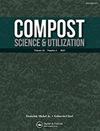大学堆肥设施的碳足迹:康奈尔农场服务的案例研究
IF 0.9
4区 农林科学
Q3 ECOLOGY
引用次数: 5
摘要
康奈尔大学农场服务部从大学周围的各个地方收集可回收的有机物,包括食堂和其他食品服务场所、兽医医院、卫星奶牛场、马和养鸡场、种植场和温室。2013年,他们将大约6714公吨的有机残留物转移到堆肥设施。开发了一份调查问卷,以从该设施获取信息,以便计算该过程中每一步的温室气体排放量,包括通过使用堆肥进行碳封存所节省的费用。研究发现,2013年,康奈尔大学的堆肥设施排放了104.6公吨碳当量(MTCE),并通过使用堆肥节省了2010.4公吨碳当量(MTCE),总碳足迹节省了96.7公吨碳当量/年(碳负)。这相当于每吨原料排放0.0154 MTCE,通过使用堆肥节省0.03 MTCE,总碳足迹节省0.0146 MTCE/吨新鲜物质。这些值是特定于该设施的,但堆肥设施可以使用问卷调查和计算来计算堆肥的碳足迹。本文章由计算机程序翻译,如有差异,请以英文原文为准。
Carbon Footprint of a University Compost Facility: Case Study of Cornell Farm Services
ABSTRACT Cornell University Farm Services collects recyclable organics from various locations around the University including the dining halls and other food service establishments, the veterinary hospital, satellite dairy cattle, horse and chicken farms, cropping operations, and greenhouses. In 2013, they diverted approximately 6714 metric tons of organic residuals to the compost facility. A questionnaire was developed to get information from the facility in order to calculate greenhouse gas emissions for each step in this process including savings from carbon sequestration through compost use. It was found that in 2013, Cornell's compost facility emitted 104.6 metric tons carbon equivalent (MTCE) and saved 201.4 MTCE through compost use for a total carbon footprint savings of 96.7 MTCE/year (carbon negative). This equates to 0.0154 MTCE/tonne feedstock emitted and 0.03 MTCE saved through compost use for a total carbon footprint savings of 0.0146 MTCE/tonne fresh matter. These values are specific to this facility, but the questionnaire and calculations can be used by compost facilities to calculate the carbon footprint of composting.
求助全文
通过发布文献求助,成功后即可免费获取论文全文。
去求助
来源期刊

Compost Science & Utilization
农林科学-生态学
CiteScore
4.10
自引率
0.00%
发文量
0
审稿时长
>36 weeks
期刊介绍:
4 issues per year
Compost Science & Utilization is currently abstracted/indexed in: CABI Agriculture & Environment Abstracts, CSA Biotechnology and Environmental Engineering Abstracts, EBSCOhost Abstracts, Elsevier Compendex and GEOBASE Abstracts, PubMed, ProQuest Science Abstracts, and Thomson Reuters Biological Abstracts and Science Citation Index
 求助内容:
求助内容: 应助结果提醒方式:
应助结果提醒方式:


